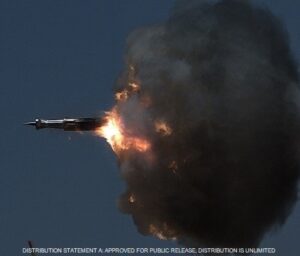HUNTSVILLE, Ala. — BAE Systems recently conducted another live fire of its new XM1155-SC long-range artillery projectile, a company official confirmed last week, noting it demonstrated the munition’s maneuvering capabilities.
Jim Miller, BAE Systems’ vice president of business development for combat mission systems, told Defense Daily the company is still unable to disclose specific ranges achieved with the XM1155-SC, while adding the demonstration in December was a “great success.”

“We’re pretty excited about this because not only did we hit a long range target, [the XM1155-SC] can do some maneuvering to gather additional range and we’re having great success on accuracy as well. So it’s not just getting the range. It’s getting the range plus accuracy. That is significant enough that they don’t need much of a warhead. The projectile’s hitting the target and having good effects without having too much high explosives inside of it,” Miller said during an interview at AUSA’s Global Force Symposium here last week.
BAE Systems and a team of Boeing [BA] and Norway’s Nammo have been developing and testing their next-generation projectile solutions under the Army’s XM1155 program to inform requirements for future long-range artillery munitions programs.
Both competitors said this past October that they had achieved record ranges in recent tests with the new projectile capabilities firing from Extended Range Cannon Artillery (ERCA) prototypes, declining to offer specific figures, while Miller said at the time he believed BAE Systems’ XM1155-SC guided munition has been fired out farther than Boeing and Nammo’s ramjet-powered 155 projectile in demonstrations to date (Defense Daily, Oct. 9 2023).
“When the Army gets interested in your success, they do things like not let you say the ranges in public. It’s the problem we have, [along] with our competitors, is we’re all excited and can’t prove to you who shot the farthest because only the Army knows right now,” Miller told Defense Daily last week. “We stand by what we said in October.”
Miller noted the XM1155-SC test in December was ““specifically about the ability of the round to be precise and do a bit of maneuvering,” adding the munition was shot at “not a new record range.”
“The round did everything we expected it to do,” Miller said. “The idea is, if we can get the seeker right, this may be able to be shot at a moving or poorly-located target and then seek it out and maneuver to that target. So we wanted to demonstrate that there was a bit of maneuverability. We didn’t want to push it too far, but we wanted to demonstrate that.”
“We proved the round is maneuverable with the right seeker to be able to hit a target like that and at a range greater than we have ever shot out of the standard howitzers that we currently have, not including ERCA,” Miller added.
The Army recently announced it has ended development of the ERCA future howitzer system and will be pivoting to a new approach that will look to consider industry’s existing capabilities, with plans to assess more mature, existing offerings from industry this summer (Defense Daily, March 12).
The ERCA development effort had focused around integrating an Army-developed 58-caliber, 30-foot gun tube on BAE Systems’ M109A7 self-propelled howitzer chassis with an aim to develop a system capable of hitting targets out to 70 kilometers at a rate of six to 10 rounds per minute.
Army officials have reiterated the service plans to continue next-generation munitions efforts that had been occurring in parallel with ERCA, as the service starts this new approach to get after the requirement for extending the range of its cannon artillery capabilities.
“What we realized is just by focusing on the round, we had a significant amount of success in extending the range [with] the round. Again, thanks to all the great capabilities that are coming out of industry,” Gen. James Rainey, head of Army Futures Command, said at last week’s AUSA Global Force Symposium.
A BAE Systems spokesperson told Defense Daily the company recently received an $18 million contract to continue work on the XM1155-SC, with Miller also noting the fiscal year 2025 budget submission includes funding for further development of next-gen artillery munitions.
“This is the kind of project that [Gen. Rainey] was talking about,” Miller said. “He was [saying] every howitzer should be able to get more range. And [new munitions] is one way they’re going to take care of the ERCA mission, which is still important even though that prototype howitzer program didn’t work out as they hoped it would. [These munitions] still give every howitzer the range that you need to get after those long targets.”